The first night's reception was in the
Santa Cruz College , established in the 15th century. Elyse
sneaked a picture in after most everyone had left as she was enamored by
the arches (below, left). We were told that it was the center of
the Inquisition - that put a slightly different light on it! While the
guys were working / learning, Jessie and Elyse toured around the city.
One of our favorite spots - especially on the really hot days - was the Campo Grande, a 115,000m2 park
with lots shade, benches and peacocks! Below are some examples of
the views we saw around town: the cathedral, the
university, one of the main plazas (named after the poet Zorilla),
and the Plaza Mayor (at night).
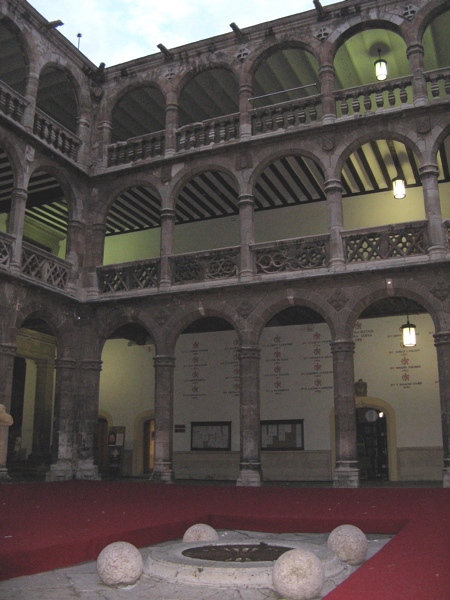
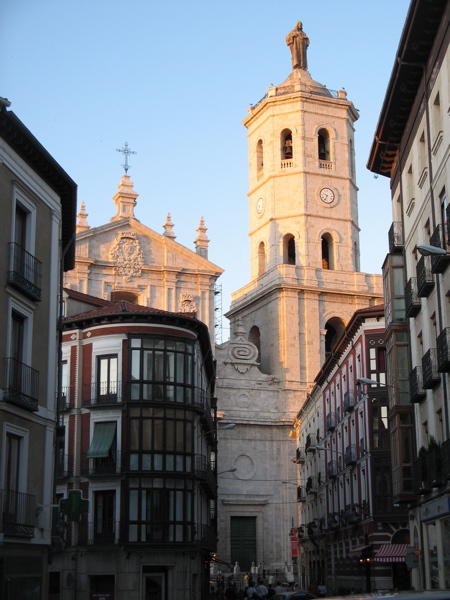
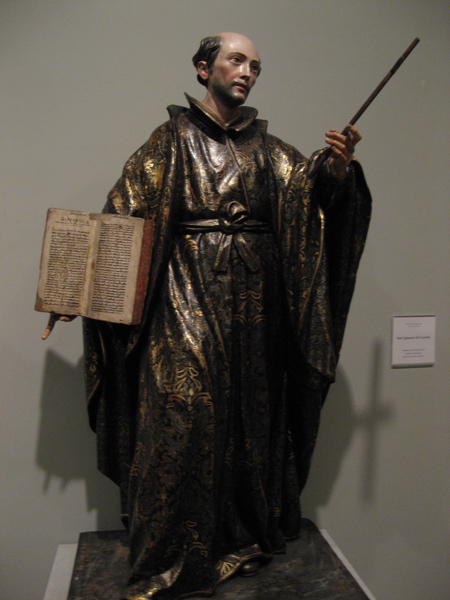
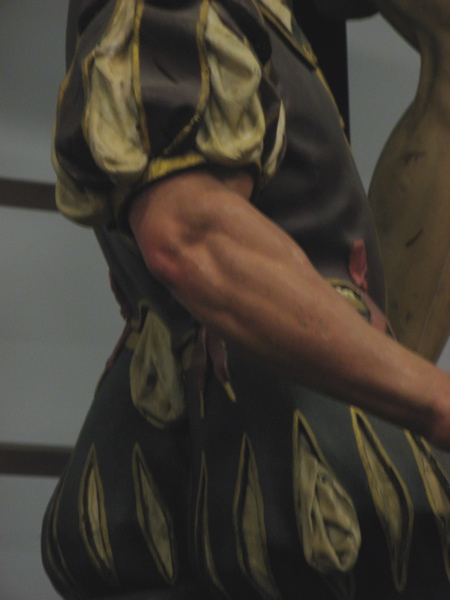
They then went to the 13th century San Pablo Church, originally founded as a Dominican convent. The facade
is currently being restored, but they (cleverly) have set up a tour via
a glass scaffold-elevator (below, left) that takes visitors up the
facade. It was fun to see all the decorations close up and
to see the workers diligently scraping off years' worth of dirt, dung
and other pollutants. The tour was in Spanish, but Jessie and
Elyse were able to understand enough (if they concentrated) through
their knowledge of French. The Spanish speak very quickly though!
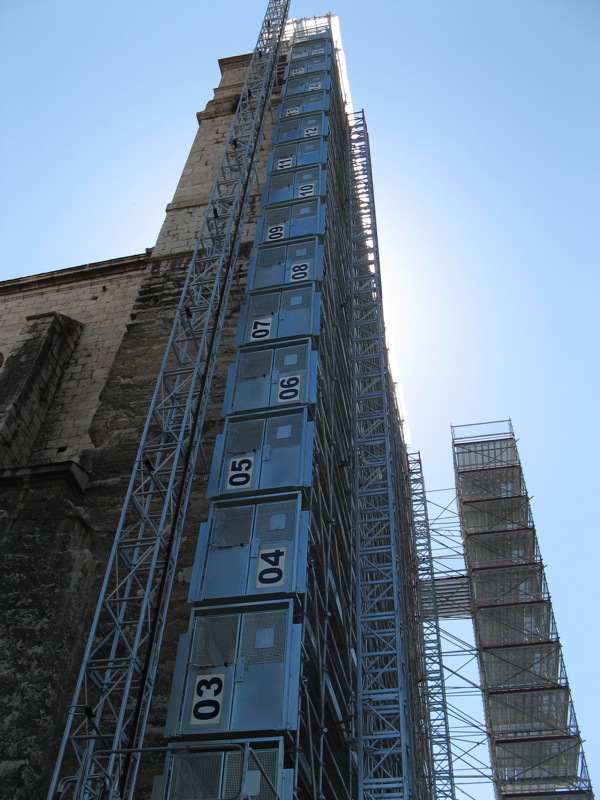
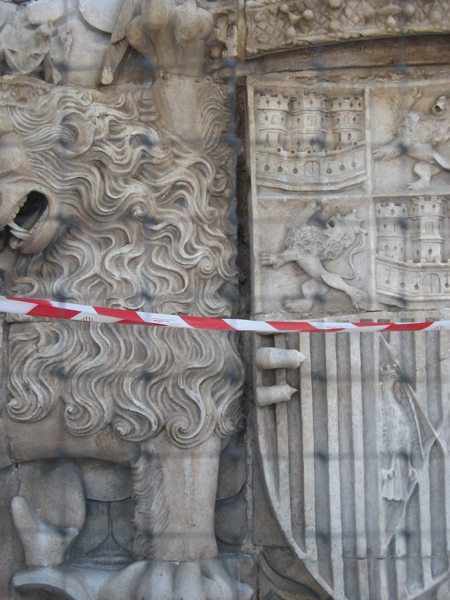
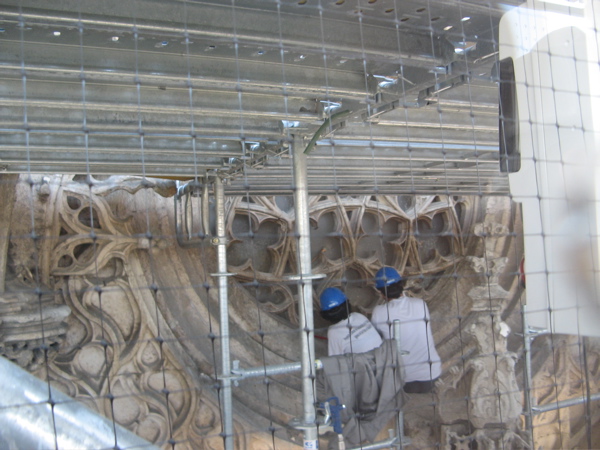
Salamanca
Another day, Elyse & Jessie took a
bus to Salamanca (about 150km / 90 miles southwest of Valladolid).
Given the heat, the siesta closing times and the bus schedule,
they only had about 4 hours there, but it was well worth the visit.
Salamanca has one of the oldest universities in the world.
It was established in 1254, although the building - pictured
below, left - is from the 15th century. One of the highlights of
that visit was the old library (pictured below right), and a small
building / dark room with a domed ceiling picturing constellations.
Other beautiful and famous sights are the cathedrals from
the 12th century and the Plaza Mayor (below), but we enjoyed walking
through the narrow streets as well. We left time to sit in the
Plaza Mayor enjoying a cold drink and pastry and watching the world go
by before catching the bus back to Valladolid.
The conference coordinators had arranged
an afternoon excursion for all the participants to go to Segovia, about
150 km /
90 miles southeast of Valladolid. They loaded us onto three coach
buses (there were a lot of people at this conference!) and drove us
through the dry, rocky landscape to Segovia. We passed many
fields of sunflowers during our travels (between Valladolid and Madrid,
Salamanca and
Segovia) and Elyse kept trying to capture their beauty. None of
the photos did the fields justice, but hopefully these give you a sense
of why she kept trying. It was quite a surprise to see Segovia
"pop up" in the midst of a dry flat valley.
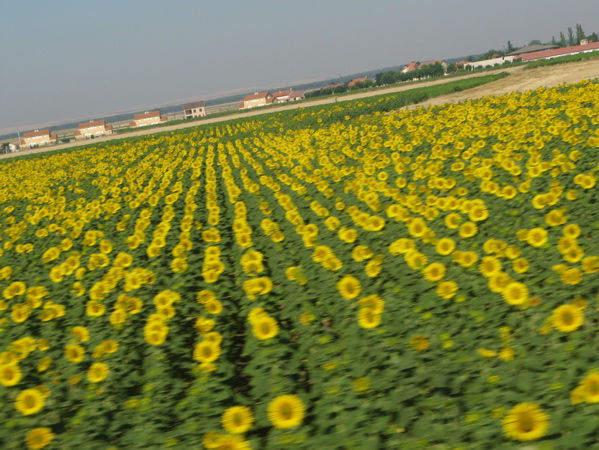
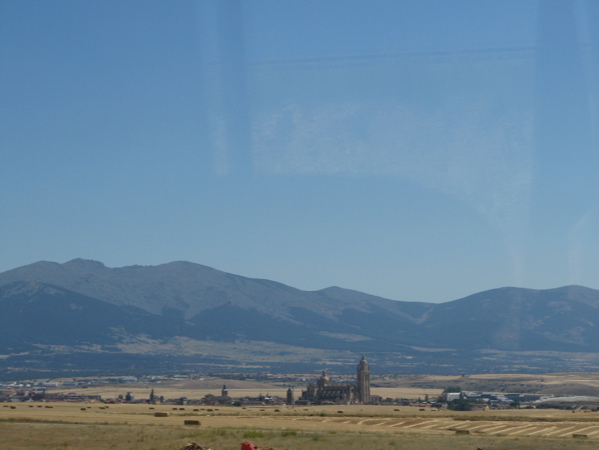
Segovia is very old. It was
originally settled by the Celtiberians and was later conquered by the
Romans. Although the town was filled with interesting
architecture and beautiful streets, it was the 1st century Roman
aqueduct that took our breath away. It is almost 2000 years
old and was still in use until the 1950s when a municipal water system
was put in place. It is almost 30m tall and spans 14 kms / 9
miles from the Guadarrama Mountains into the city, with about 800m
above ground through the valley in which Segovia sits. It is made
up of about 20,000 blocks and delivered about 30 liters of water per
second! And if that weren't all impressive enough, no cement or
mortar holds the bricks together - it is just perfectly designed!
It was truly awesome to see.
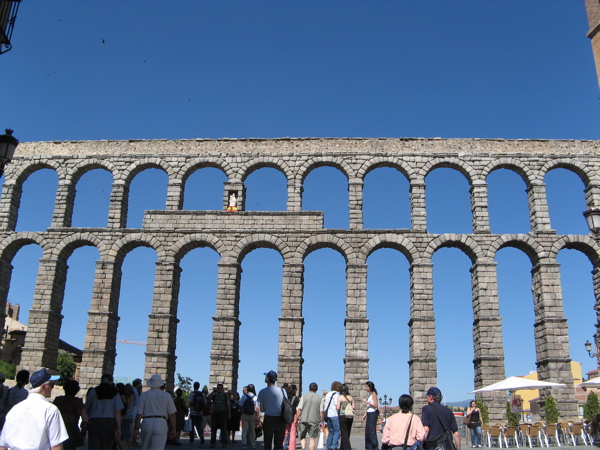
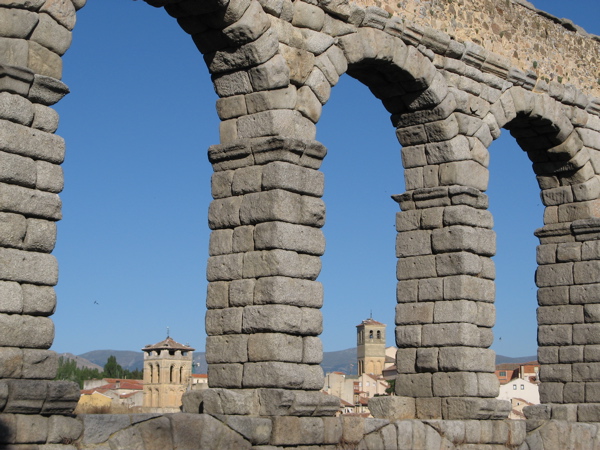
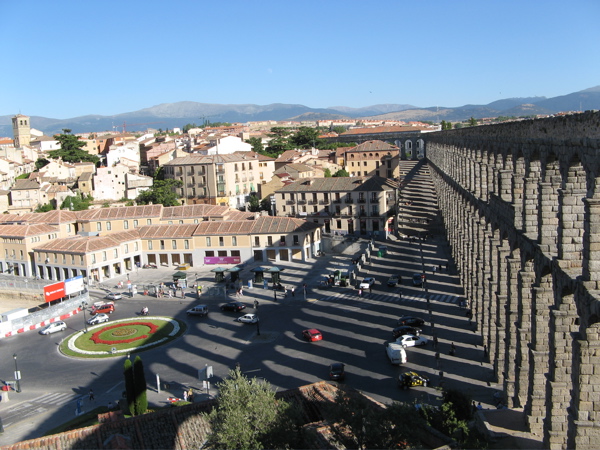
The rest of the town included many
beautiful churches (there were 20 Romanesque churches at one point),
including the 12th century San Martin (below, left) and the
huge 16th century Cathedral. (below, right).
There were three different neighborhoods for the Jews (there were five
synagogues at one point), Christians and
Moors. We enjoyed wandering through the streets - many of which
were quite narrow. Each neighborhood had many beautiful
buildings, most of which (in all 3 areas) had private courtyards
(below, left) that felt about 10 degrees cooler, and/or adopted the
Moorish custom of decorating the facades with
geometric designs (see below for one that went as far as to make the
design 3-dimensional! This photo is looking up the wall).
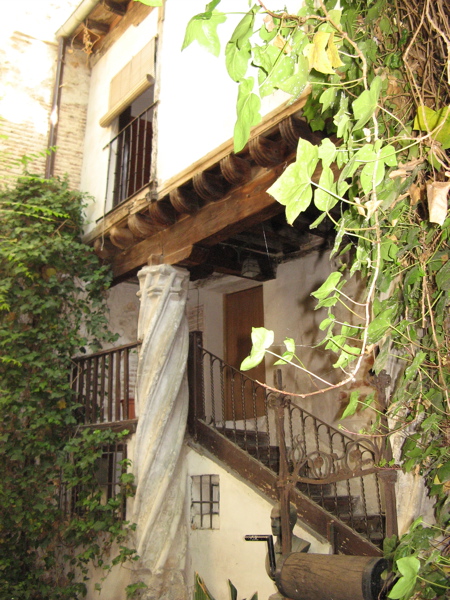
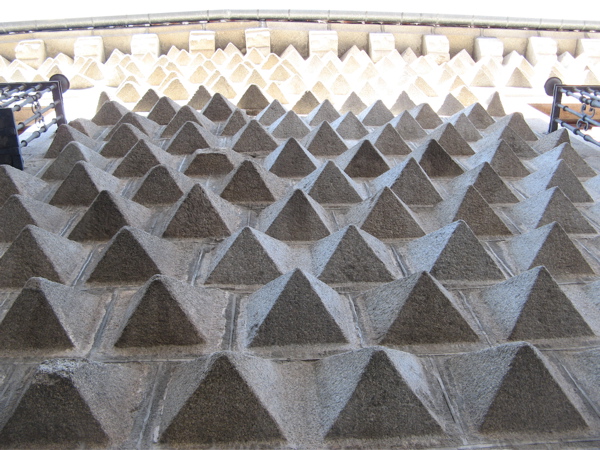
The 12th century castle - Alcazar
- shows an example of the wall designs. The castle was later used
as a prison and a military academy until it was mostly gutted by a fire
in the 19th century. It overlooked a high cliff and looked like
it would be hard to capture. We didn't have time to go inside,
but apparently some original items survived the fire and others from
the various periods have been donated to the collection.
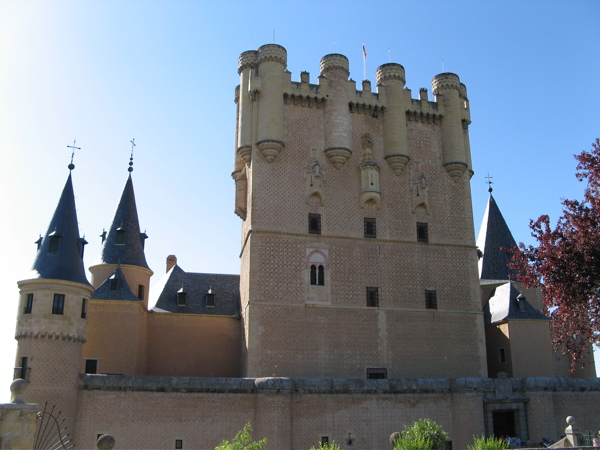
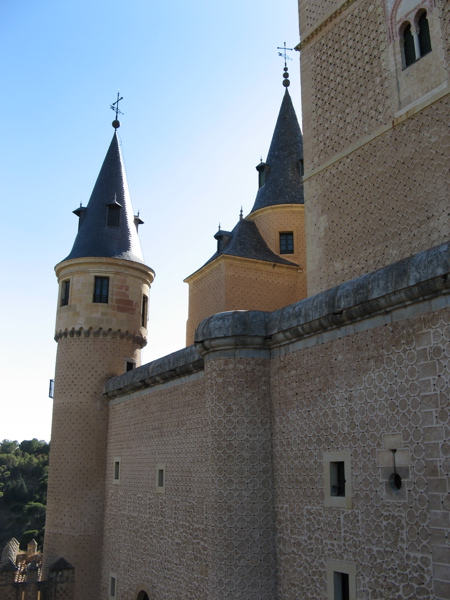
Despite the hot weather and short time,
we had a wonderful visit and very much enjoyed seeing Segovia -
especially that aqueduct! The rest of the time in Valladolid was
also very nice. We sampled their specialty of milk-fed lamb
(delicious) and the deep red wines of the Ribera region and enjoyed the
many choices offered at the Tapas bars. That is definitely one of
our favorite ways of eating - lots of different tastes!
HEIDELBERG & SURROUNDINGS
We finished our packing and cleaning the apartment early in the week so
that we would have some free time to relax and enjoy Heidelberg before
leaving. Luckily for us, Wednesday proved to be a spectacular
day: warm (but not too warm) and sunny with a cool breeze. We
took our bikes on the train to Neckarsteinach (where Elyse had gone a
few weeks before) and walked around the town. Then we biked over
and up - way up - to Dilsberg (the name kept reminding Elyse of the
cartoon, Dilbert) where we visited the old castle and were afforded
some fantastic 360-degree views of the Neckar Valley and its small
towns (below, left and right). We then biked back along the river
to Neckargemund where we ate a tasty pumpkin seed-cheese-pretzel by the
river and soaked in the fresh air.
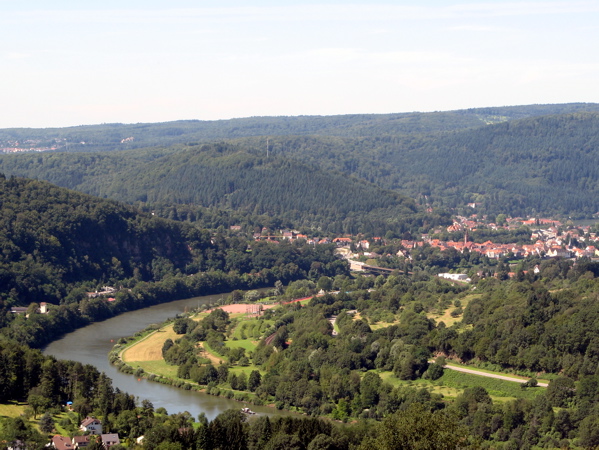
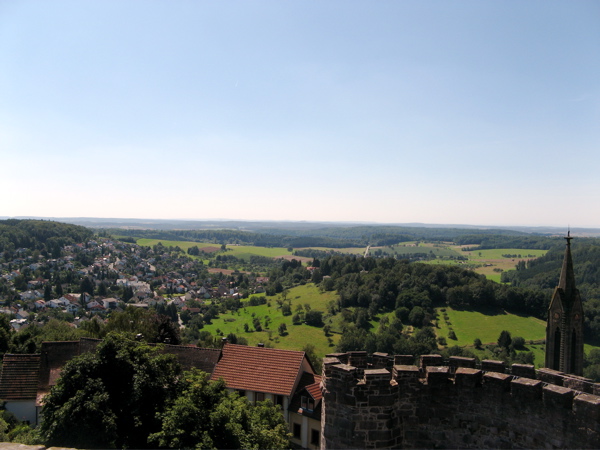
The ride from there back to Heidelberg was mostly through the forest
(shady and cool) which was nice. Our legs were pretty tired (did
we mention that the road up to Dilsberg was quite steep?), but we
wanted to visit the Heidelberg castle one last time. We stopped
in the old town at our favorite bakery and got our absolute
favorite cherry pastry - and an almost-as-good apple pastry - and hiked
up to the castle gardens. There were a lot more tourists there
now than there were when we first arrived, but it was still beautiful
and a wonderful way to end a phenomenal year. We're really
signing off now. We hope you've enjoyed the ride along with us!